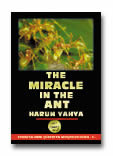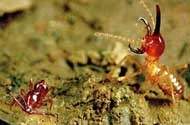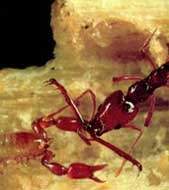The Miracle In The Ant

|
Chapter 7 Feeding And Hunting Each living being uses different methods to satisfy its needs for food. In this chapter, you are going to read about the tactics used by ants when looking for food, about their communications and the competition among them to get to the food. All the tactics tried by such a small creature to obtain its food shows, as in previous chapters, the greatness, magnificence and power of Allah, the "Supreme Possessor of Intelligence" Who has created them. How is a "family" with a population in hundreds of thousands fed? One of the most important things needed for survival of the colony is resolving of the food problem, and each ant in the colony has its share of this responsibility. As they do in other aspects of their lives, the ants carry out systematic work in solving the nutrition problem. Old worker ants are sent out as foragers to survey the land around the nest to find food resources for the colony which has a population of hundreds of thousands (sometimes millions). When forager ants find a food source, they gather their nestmates around the food in numbers which depend on the size and richness of the source. Ants solve the food problem by a very strong communication network and their generosity, which never says "Only me". .
Ants That Feed Each Other
Then, how do the ants feed during this fight, when they have no opportunity to bring in food? At this point, a feature of the ants that distinguishes them from other living beings emerges. During this period when they cannot search for food, all colony members feed on the food stored in the crops of young workers. In fact, this sharing technique is one they use all their lives, and not only at special times. Ants not only transport the liquid droplets, but they feed each other mouth to mouth. Once a forager enters the nest laden with liquid food, she stands still for a period of time, swinging its head from side to side while waiting for a nestmate to approach; or else it moves directly toward nestmates and presents them with the food droplet held between her widely opened mandibles.84 This liquid food exchange, done by regurgitating which provides quick distribution of the food to the colony is, in fact, quite an impressive example of sharing. Also husks and seeds brought to the nest are consumed as well by all of the ants together. Thus, the food requirement of the whole colony is satisfied without any problems. This system is one that makes it necessary to admit of the existence of a supreme designer. It is a reality that a chain of random events cannot form such a storage system so complex and requiring great sacrifice. What is more, each ant comes to this world knowing this system. That is, the necessity to share its food has been ingrained in it before its birth and not after. Not only has this sense of sacrifice been inspired in it, but because a special mechanism is needed to present the food it has saved in its crop, its body structure has been designed to make this sharing possible. This sharing event realized among ant colonies once again renders the word "chance" insufficient or even meaningless, due to the sense of self-sacrifice being much in evidence. As we have emphasized many times before, the theory of evolution assumes the existence of a full-fledged competition and life struggle among all living things. Therefore, examples of self-sacrifice among ant species are acts most difficult to explain. Ants living under a feeding system based on sharing are proof that they do not act in the way suggested by the theory of evolution. They are not engaging in a random "fight for survival" but are rather performing the duties given to them (according to the Qur'an "revealed to them") and thus they are able to transform their colonies with hundreds of thousands or even millions of members into a true civilization. In the Qur'an, in surat an-Nahl, Allah describes the "revelation" that makes it obligatory for the animals to perform certain tasks given to them by Him: And your Lord revealed to the bee: "Build dwellings in the mountains and the trees and also in the structures which men erect. Then eat from every kind of fruit and travel the paths of your Lord, which have been made easy for you to follow." From inside them comes a drink of varying colours, containing healing for mankind. There is certainly a sign in that for people who reflect. (Surat an-Nahl: 68-69) The Qur'an, of course, does not list the animals' special duties through Allah's inspiration one by one. The honey bee is just one example. Yet, when we look at the ant, we can see that this small being, which performs as perfect tasks as the honey bee, and which is at least as generous, social and loyal, acts under a similar revelation.
Rational Techniques In Carrying Food
If the food they find is in suitable dimensions for them, ants usually carry it alone. If the food is too large for a single ant to carry or if it is in small piles, all within a particular area, they give out a poisonous hormone to prevent others from coming into the territory. Then they go to call other workers, large and small, to carry the food. The perfect division of labour governing the lives of ants is observed here also. Large ants tear up the food and defend it against strangers, while smaller ones take care of carrying the pieces home. A worker lifts the food with its mandible and keeps it in front of it while returning home. When there is a group, the substance they can carry becomes even larger. They lift the food by using one or two legs. At the same time, they bite the food, opening their mandibles. Workers apply different techniques, depending on their positions and their directions. Those in front walk backwards, pulling the food. Those at the back walk forward, pushing it, and those at the sides give support. By this technique, it is possible to carry weights many times greater than what a single ant can carry. In fact, it has been observed that ants acting in unison can carry a weight 5,000 times as heavy as that carried by a single worker. 100 ants can carry a large worm at ground level, moving it 0.4 cm per second.
Ants and Odor TrailsCommunication by trails (following of odor trails) is a technique that is commonly used by ants. There are many interesting examples on the subject:
An ant species living in American deserts secretes a special odor produced in its venom sac if it realizes that the dead bug it has found is too wide or heavy to carry or drag. Its nestmates far away detect the odor and start moving towards its source. When ants have gathered around the victim in sufficient numbers to carry it, they start carrying it towards the nest. When fire ant workers leave the nest in search of food, they may follow odor trails for a short while, but they eventually separate from each other and begin to explore singly. When a fire ant discovers a food source, it heads home at a slower pace. Her entire body is held closer to the ground. At frequent intervals, the sting is extruded, and its tip is drawn lightly over the ground surface, much as a pen is used to ink a thin line. Thus, it leaves a trail behind it that leads to the food source.85
Ants Who Serve As CompassesFood-seeking ants carry out a task in a manner which is very hard to explain. They go to the food source following a wiggly path, but when they return home, it is via a short and straight line. Then, how is it that ants that can see only a few centimetres ahead of themselves, march in such a straight line? To find an answer to this question, a researcher called Richard Feynman placed a clump of sugar at one end of the bathtub, then waited for an ant to come and find it. As this pioneer ant returned home with news of the feast, Feynman followed the wiggly path it followed. He then traced the path of each successive ant to follow the trail. The successive ants, he found, did not stick exactly to the trail; they did better, cutting corners until the trail became a straight line. Later on, inspired by Feynman, a computer scientist, Alfred Bruckstein, proved mathematically that successive followers really do make a wiggly line straight. The conclusion he arrived at was the same: after a certain number of ants, the path length shrinks to some minimum value: to the shortest possible distance between two points - namely, a straight line.86 What we talked about above is of course, something which would require great skill on the part of a human being because he would certainly need to use a compass, a watch and at times much more complex instruments for any distance relative to his own dimensions and would have to have a perfect knowledge of mathematics. In contrast to this, the guide an ant has in exploring on its own is the sun, while its compass is the position of branches and other natural landmarks. Later on, ants remember their shapes and can thus find the shortest route to their nests although they have never had any prior knowledge of it. This is very easy to say but very hard to explain! How can these tiny living beings do such calculations when they have neither a brain nor the capacity to think and judge? Imagine that you leave a man in an unfamiliar forest. Even if he knows the direction to go, he will have a hard time finding his way and will probably get lost. In the meantime, it will be necessary for him to look around carefully and think about which would be the best way to go. Yet, ants act as if they are encoded on the matter of path finding. In the evening, they can easily find and follow the road they took to find the food in the morning, even if all the conditions have changed.
The Perfect Hunting TechniqueCertain ant species use their teeth to eat spider eggs, caterpillars, insects and termites. Many ants (for example Dacetine) specialize in non-winged insects. These insects live in groups in the ground and in decayed leaves. The bugs have extensions under their bodies in the form of folded forks. When they rock and get up, this organ throws them into the air and forward like a miniature kangaroo. Dacetine ants use their mandibles like an animal-catching trap against this very effective manoeuvre. When the food-seeking ant receives the odor of an insect with its antennae, it lies in wait, opening its mandibles 180 degrees. It locks the small teeth in its mandible by pressing onto its upper palate. It inspects its surroundings by moving its antennae forward. Then the ant approaches the insect slowly. When its antennae touch it, the little insect is at a distance where its apical teeth can reach it. When the ant lowers its palate, the mandible suddenly snaps shut and the insect is squeezed between the teeth as if impaled.87
Our speed of blinking the eye is very slow compared to the biting speed of the trapper ant. While the opening and closing of the eyelid takes about one third of a second, the mandibles of these ants (Odontomachus bawi) work almost 100 times faster. The fastest hit observed took in 0.33 milliseconds.88
It is impossible for such a hunting mechanism to have developed through evolution. That is, without conscious design and at random. The only acceptable truth is that the power who has created the ants with all their miraculous characteristics and perfect life styles is Allah, Who is sovereign over all of nature and the universe.
|
||
| |

 Ants of different species try not to get in each other's way while looking for food. Each one determines a path for itself to get to the food source. If ants go into another colony's territory by mistake, this becomes a declaration of war. In such a situation, forager ants come back to the nest right away and close the nest entrance and all colony members come together to defend their colonies against danger.
Ants of different species try not to get in each other's way while looking for food. Each one determines a path for itself to get to the food source. If ants go into another colony's territory by mistake, this becomes a declaration of war. In such a situation, forager ants come back to the nest right away and close the nest entrance and all colony members come together to defend their colonies against danger.  The discovery by approximately 8800 known ant species of the food sources they need, and their carrying them to their homes are done by different methods. In certain species, ants hunt on their own and carry the food individually. Yet in others, hunting is done as a group and they carry and defend their food together.
The discovery by approximately 8800 known ant species of the food sources they need, and their carrying them to their homes are done by different methods. In certain species, ants hunt on their own and carry the food individually. Yet in others, hunting is done as a group and they carry and defend their food together. 
 The above-mentioned ants never miss their prey, because they have mandibles with the fastest reflex in the world.
The above-mentioned ants never miss their prey, because they have mandibles with the fastest reflex in the world. 